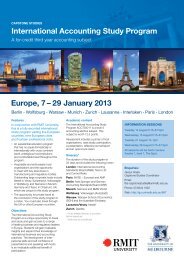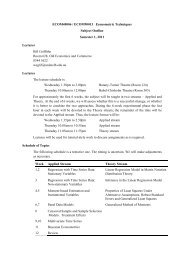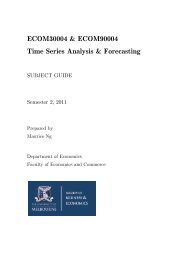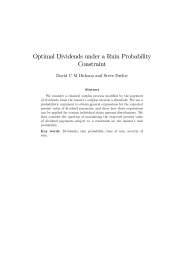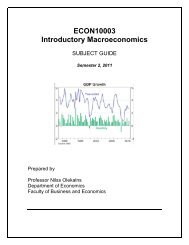A Model of Optimal Corporate Bailouts - Faculty of Business and ...
A Model of Optimal Corporate Bailouts - Faculty of Business and ...
A Model of Optimal Corporate Bailouts - Faculty of Business and ...
Create successful ePaper yourself
Turn your PDF publications into a flip-book with our unique Google optimized e-Paper software.
Finally, our model suggests that bailouts are better funded through special taxes on healthyfirms than through retrospective assessments on bailout recipients (in the form <strong>of</strong> governmentowned debt <strong>and</strong> equity). Early drafts <strong>of</strong> the 2010 Dodd-Frank Act proposed the creation <strong>of</strong> $50billion bailout fund financed by healthy firms deemed to be systemically significant. Ironically,opponents in the Senate ultimately blocked this proposal, asserting that it would exacerbatemoral hazard (?). Our model suggests, quite to the contrary, that the bailout fund approachcan be well suited to mitigate the moral hazard that bailouts inevitably introduce. 2As with any theoretical model, our prescriptive insights are subject to caveats <strong>and</strong> limitationsthat depend on context.First, if the government forces out the owners <strong>and</strong> managers <strong>of</strong> failed firms, equallycompetent replacements may not be readily available. Yet, because these parties are the sameones that presided over their firms’ declines, they are plausibly dispensable—as they were inthe aforementioned GM <strong>and</strong> Chrysler bailouts. 3 Nevertheless, in Section 4.1, we show thatour model is robust to introducing an efficiency loss when a competent party would have tobe succeeded by a less competent replacement. If this loss is large, the government may ormay not choose not to remove incumbent owners or managers <strong>of</strong> bailed out firms, even ifcommitting to do so would still be optimal ex ante. Consequently, the absence <strong>of</strong> competentreplacements tends to contract (but not necessarily eliminate) the set <strong>of</strong> contingencies whereintervention is socially beneficial.Second, our model identifies one costs <strong>of</strong> government intervention to be the need to taxfirms ex-ante to cover the cost <strong>of</strong> subsidies. This reduces the manager’s effort <strong>and</strong> thus creates asocial cost. In Sections 4.2 <strong>and</strong> 4.3, we show that our model is robust to extending the taxationbase, either to firms that are not potentially subject to bailouts, or, even more broadly, to otherparties. (For example, stakeholders who benefit from the continued existence <strong>of</strong> the firm wouldbe a natural source for tax revenues.) Enhancing the government’s ability to tax exp<strong>and</strong>s thecircumstances in which intervention is socially beneficial.Third, our analysis presumes that the government’s goal is to maximize expected socialwelfare (subject to budget balancing <strong>and</strong> general incentive/participation constraints). Althoughthis goal seems defensible on both positive <strong>and</strong> normative grounds, governmental actors mayepisodically harbor other objectives—such as maximizing the return on investment in bailed-outa team <strong>of</strong> unusually competent outside private-equity capitalists with business expertise. Moreover, it appearsthat the task force was not as motivated by a desire to enrich itself, as by a desire for public service (which ourmodel does not allow for). Thus, the government may have followed not the letter, but the spirit <strong>of</strong> our model’srecommendation. And, as our model suggests, by 2010, the government had begun to divest its stake in GM.2 It is debatable whether the government will have the capability not to intervene if it will be socially optimal tointervene. Our model suggests that a commitment to expropriate the corporate owners <strong>and</strong> managers may bemore effective than an attempt to limit the pool <strong>of</strong> funds for bailouts in the future. After all, there was no suchfund in place in 2008-9, either, <strong>and</strong> yet the government did rescure firms.3 Recall also that, in our model, we do not expect the government to train managers, to manage the firm itself,or to control the firm in an active fashion. It is <strong>of</strong>ten implausible that government can do this better than thefree market. In our model, government primarily intervenes with funding, <strong>and</strong>, if it does so, secondarily with theability to force the firm to fire the manager.6



